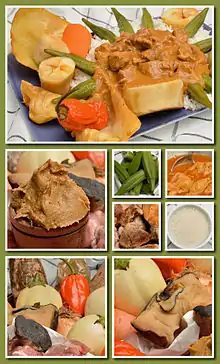Peanut stew
Peanut stew or groundnut stew, also known as maafe (Wolof, mafé, maffé, maffe), sauce d'arachide (French) or tigadèguèna is a stew that is a staple food in Western Africa.[1] It originates from the Mandinka and Bambara people of Mali.[2]
 Maafe | |
| Alternative names | Groundnut stew |
|---|---|
| Type | Stew |
| Place of origin | Mali |
| Region or state | West Africa |
| Main ingredients | Meat (lamb, beef, or chicken), tomatoes, onions, garlic, cabbage, leaf or root vegetables, peanuts |
The proper name for it in the Mandinka language is domodah or tigadegena (lit. 'peanut butter sauce,' where tige is 'peanut,' dege is 'paste,' and na is 'sauce') in Bamanankan.[3]
Domodah is a sauce also used by Gambians, whose name has been borrowed from the Mandinka language.[4][5] In Senegal domodah or domoda refers to flour-thickened soup or stew, which is different from mafe that uses peanut paste.[6] It is a favorite dish among several Senegal and Gambia ethnic groups. With the significant expansion of groundnut cultivation during the colonial period, maafe has also become a popular dish across West Africa, even outside West Africa such as in Cameroon and France.
Variants of the dish appear in the cuisine of nations throughout West Africa and Central Africa. It is very similar to groundnut soup. It may be prepared with lamb, beef, chicken, or without meat.[7][8][1][9] In Ghana, this stew is usually eaten with fufu.[9]
Variations
Recipes for the stew vary widely, but commonly include chicken, tomato, onion, garlic, cabbage, and leaf or root vegetables. Other versions include okra, corn, carrots, cinnamon, hot peppers, paprika, black pepper, turmeric, cumin, and other spices. Maafe is traditionally served with white rice (in Senegal, Mauritania, Guinea-Bissau and Gambia), fonio or to (millet dough) in Mali, tuwo or omo tuo (rice or millet dough) in Northern Nigeria, Niger, and Northern Ghana, couscous (as West Africa meets the Sahara, in Sahelian countries), or fufu and sweet potatoes in the more tropical areas, such as the Ivory Coast. Um'bido is a variation using greens, while Ghanaian maafe is cooked with boiled eggs.[10] A variation of the stew, "Virginia peanut soup", even traveled with enslaved Africans to North America.[11]
The Gambia
Domoda is a type of groundnut stew found in The Gambia.[12] Domoda is prepared using ground peanuts or peanut butter, meat, onion, tomato, garlic, seasonal vegetables and spices.[12][13] It has been described as one of the national dishes of The Gambia.[13] Domoda is typically served over rice, and is also sometimes served over findi, a grain that is similar to couscous in consistency.[13]
Gallery
.jpg.webp) Groundnut stew prepared with fried groundnut paste, fish, eggs and hot palm oil
Groundnut stew prepared with fried groundnut paste, fish, eggs and hot palm oil Domoda served with rice
Domoda served with rice
See also
References
- Collective, The Moosewood; Scherer, J. (2013). Moosewood Restaurant Favorites. St. Martin's Press. p. 127. ISBN 978-1-250-00625-7. Retrieved September 9, 2016.
- James McCann. Stirring the pot: a history of African cuisine, p132. Ohio University Press, 2009ISBN 0-89680-272-8
- "The Hirshon Malian Peanut Stew – Tigadegena". ✮ The Food Dictator ✮. 2016-09-22. Retrieved 2020-05-29.
- James McCann. Stirring the pot: a history of African cuisine, p132. Ohio University Press, 2009. ISBN 0-89680-272-8
- Emma Gregg, Richard Trillo. Rough guide to the Gambia, p39. Rough Guides, 2003. ISBN 1-84353-083-X
- Saine, Abdoulaye (2012). Culture and customs of Gambia. Greenwood. ISBN 978-0-313-35911-8. OCLC 881315512.
- Dorinda Hafner. "Maafe - Chicken And Peanut Stew - Mali". Chef2Chef culinary portal. Archived from the original on 2007-02-03. Retrieved 2007-03-03.
- Ester Goody (2012). "Ghanaian Groundnut Stew". In Jessica Kuper (ed.). The Anthropologist'S Cookbook. Taylor & Francis. pp. 81–83. ISBN 978-1-136-16789-8.
- Wright, C.A. (2012). "Groundnut Stew from Ghana". Best Stews in the World: 300 Satisfying One-Dish Dinners, from Chilis and Gumbos to Curries and Cassoulet. Harvard Common Press. p. 408. ISBN 978-1-55832-787-0.
- Um'bido (greens & Peanuts) Recipe Archived 2016-03-03 at the Wayback Machine
Ghanaian Maafe: My Changing Memories of Mafe - Where Settlers, Slaves and Natives Converged, a Way of Eating Was Born, By Geneva Collins, Washington Post Staff Writer, Wednesday, May 9, 2007; Page F01.
- Jacob, J.; Ashkenazi, M. (2014). "The Gambia". The World Cookbook: The Greatest Recipes from Around the Globe, 2nd Edition: The Greatest Recipes from Around the Globe. Vol. 1. ABC-CLIO. p. 481. ISBN 978-1-61069-469-8.
- Saine, Abdoulaye (2012). Culture and Customs of Gambia. Culture and customs of Africa. Greenwood. p. 95. ISBN 978-0-313-35910-1.
Further reading
- Kitchen Window: My Changing Memories of Mafe, Afi-Odelia E. Scruggs. NPR.org, November 9, 2005
- EATS & DRINKS:Incomparable Senegalese, Tama Janowitz, New York Press, (nd). Credits Maafe as a Malian dish.
- The Modern Soul of African Cuisine, Food Product Design news, 05/04/2007.
- chicken and vegetables braised in peanut sauce. Gourmet Magazine, January 2002. Credits Maafe as a Bambara dish.
External links
- Mafe recipe
- variation of the Senegambian recipe
- Um'bido recipe, variation of maafe
- Malian recipe: Dorinda Hafner, A Taste of Africa (2002)
- Senegalese maafe recipe, ascribing a Malian source
- Mafe recipe, Ivory Coast variation
- Maffé à la viande, with lamb (in French)